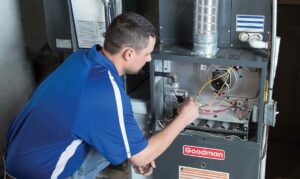Best Indoor Humidity
So what’s the ideal humidity for a home? Sufficient airflow, proper humidity levels, and adequate heating and cooling are ingredients to a comfy home. While the HVAC system takes care of heating, cooling, and air conditioning, it won’t entirely care about your home’s humidity levels.
It would be best if you had a humidifier, thermostat with a humidity control function, or humidistat to control overall humidity levels in your home. These systems have automated processes that detect and adjust to keep indoor humidity comfortable.
What is My Home’s Ideal Humidity Level?
Health Canada recommends keeping the indoor humidity level between 30% and 55%. Standardized home humidity can prevent mold growth, increase overall indoor room comfortable and extend the life of your HVAC system.
While this is the standard level, multiple factors will determine the perfect humidity levels for your home, including home, outdoor, and health conditions. You can assess your home’s humidity level using a TP50 hydrometer.
Adverse Effects of Higher than Normal Humidity Levels
When your home’s humidity hits exceptionally high levels, it translates to discomforts and health issues. High moisture levels create an excellent bleeding home for viruses, mold, bacteria, mildew, and fungi.
These are known air pollutants that affect the quality of air flowing to your indoors. If you’ve allergy and asthma patients, high humidity levels could worsen their conditions.
When the humidity levels are extremely high, your home indoor air will feel stuffy, and your body will feel hotter than average. Left uncontrolled for an extended period, the high humidity levels will cause condensation of the walls and windows.
Adverse Effects of Extremely Low Humidity Levels
Lower than average humidity levels in your home can trigger various health problems. When the humidity is extremely low, the air becomes drier, which can cause respiratory tract problems. Low humidity levels can also worsen the condition of allergy and asthma sufferers and cause the rapid spread of flu and cold viruses.
Staying in a room with lower humidity levels will make your skin and air passageways dry and your lips chapped.
Even during cold winter climates, when the room humidity level is low, your body will always feel cold. To stay comfortable, you’ll want to turn on your heating and cooling system to raise the temperatures, which means more energy bills. Dry air can also make wooden products crack and warp.
Leading Causes of High Humidity Levels in Your Home
High humidity levels in your home are triggered either by internal or external forces. Internal sources are things that introduce moisture to your interior spacing, including people, bathrooms, and kitchens.
As for external forces, they include things that introduce moisture into your indoor spaces from the exterior. The leading external triggers of increased indoor moisture include poorly maintained HVAC systems, windows/doors, and cracks.
Leading Causes of Low Humidity Levels in Your Home
Low humidity levels in your home can happen when you use your heating system for an extended period in winter. Heating systems introduce hot air to the atmosphere and eradicates the cold air and moisture.
When the heating system operates longer, more moisture will be removed from your home, leading to lower humidity. Cold air can barely hold moisture for long. So when cold, dry air from the exterior flows into your home in winter, your room may feel more dehydrated and less comfortable.
Ideal Humidity for a Home – How to Know When You Have Poor Humidity Levels
When your home is having humidity issues, there are various signs you should not ignore. Many homeowners feel the discomfort of indoor air issues.
When there are humidity issues, the air flowing into your interior spaces will lack adequate oxygen. It will be full of contaminants and pollutants. When your indoor air humidity levels are balanced, you’ll have lower issues with fluffiness or dryness.
The humidity levels in winter and summer can be extremely high, so it’s vital to control them to reduce the side effects. The following are some signs that your home humidity levels are excessively high or lower than expected.
- Visibly window condensation or water staining on the walls
- Paint blisters or peelings in areas where you have mounted wallpapers
- Musty and weird odors from the crawl and basement spaces
- Increased cases of allergic reactions and airborne diseases
- Muggy or sticky indoor air
- Development of mold in the washrooms
- You’re constantly sweating when in the home indoors
- Challenging falling asleep
Best Ways to Balance Humidity Levels in Your Home
In many instances, it’s straightforward to tell when your home has lower or higher than normal humidity levels. If it’s not poor indoor air quality, it’s high levels of discomfort or damp air smells. Whatever the sign you detect, here are some practical ways to keep your home indoor air balanced.
When your home indoor feels clammy or musty, open your windows to let out the accumulated moisture.
- Get the exhaust fans in your home vented from the exterior side
- Invest in high-quality insulation
- Get all cracks in your bathroom or ceiling sealed
- Invest in a high-quality humidifier to aid in balancing the humidity levels
- Get the indoor temperatures controlled
- Optimize bathroom and kitchen ventilation
- If the issues persist, consult with your HVAC technician.
Regulating humidity levels need more than just having the right humidifier and HVAC system. Practice the suitable approaches to efficient ventilation, humidity prevention, and control, and make sure to seal any cracks in your home.
The Ideal Humidity for a Home – Conclusion
As we recently mentioned, multiple things determine the ideal humidity for a home. While the standard home humidity falls within 30% and 55%, the exact humidity level will depend on your home and the year’s season.
The essential troubleshooting tips will work if the humidity problem is manageable with minimal effort. If the problem is in your heating system or home, you should contact an experienced HVAC technician or Plumber.






